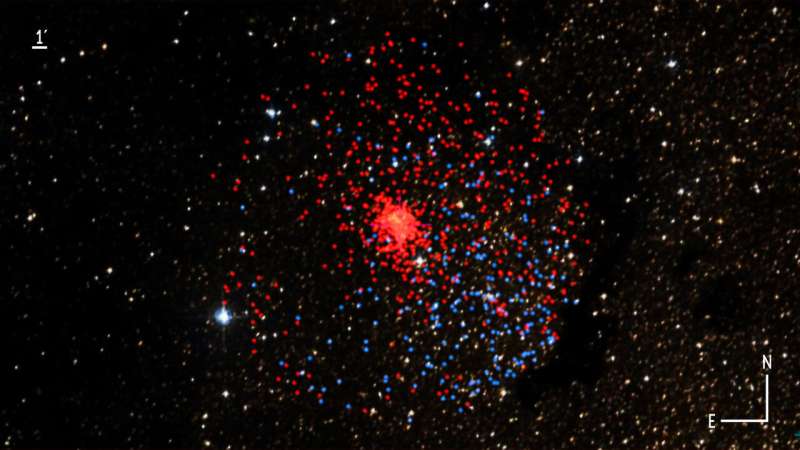The Westerlund 1 cluster: A giant stellar nursery amidst darkness

Stars tend to form in clusters or groups of between ten and several thousand stars that share the same age and composition, although in different evolutionary phases. Among the clusters in the Milky Way, the very young Westerlund 1 (Wd 1) cluster stands out in its inner regions. With an age of less than ten million years—for comparison, the sun is five billion years old—it is considered the most massive cluster in our galaxy. Its population is an ideal laboratory for studying massive stars, yet hidden behind a dusty region that makes it difficult to study. Now, a team of scientists has broken through this "darkness" to estimate the cluster's distance with high precision, and analyze the surrounding stellar population.
The star population associated with Westerlund 1, which looks like a glossary of giant objects, encompasses all kinds of massive stars. They range from O-type giants and supergiants to red supergiants, several extremely luminous B-type hypergiants, several yellow hypergiants, and others. Some show rare evolutionary phases and different interaction pathways in binary systems, making this group of stars the ideal sample to unravel the evolutionary processes of giant stars. However, the precise determination of the stars' masses and ages depends on the parameters derived for the cluster, one of the main unknowns has been their distance so far, as well as the effect of light extinction due to dust in these regions.
According to the head of the study and University of Alicante Professor of Astronomy and Astrophysics Ignacio Negueruela, Wd 1 is, without a doubt, one of the most interesting objects in our galaxy. Due to the enormous amount of dust along our line of sight, even a telescope as advanced as Gaia has difficulty giving us high-quality data. Therefore, complex statistical processing to the observations has been necessary to apply in order to give such an accurate value for the distance. However, Gaia has provided us with much more information, as it has revealed the true size of the cluster and allowed us to identify stars in the cluster that were not known before.
Researcher at the Andalusia Astrophysics Research Institute (IAA-CSIC) and co-author of the paper Emilio J. Alfaro highlights the key role of the Gaia data for selecting the stars that belong to the cluster and determining their precise distance. The cluster is about thirteen thousand light-years from the sun, which implies that its mass is closer to a hundred thousand solar masses than to a few tens of thousands, making it the most massive young star cluster in the Local Group, except for R136 in the Large Magellanic Cloud.
The Gaia-EDR3 data, together with new spectroscopic observations obtained with AAOmega (Anglo-Australian Telescope Omega Spectrograph), have allowed the team to find a large concentration of blue stars that may be located about six and a half thousand light-years from the sun, representing a hitherto unknown star-forming complex or spiral arm segment.
The detection of a concentration of blue stars, with an angular motion very close to that of the cluster—yet at a smaller distance—requires a more detailed study to show its nature and origin. This direction of the galactic plane is very rich in young stars, and the determination of the distance of Wd 1 also indicates the probable position of one of the inner spiral arms, which is essential for understanding the complex spiral structure of the Milky Way, as the researchers explained.
Only globular clusters—old concentrations of stars in the galactic halo—have a mass range comparable to or greater than that of Westerlund 1 (between ten thousand and one million solar masses). Nevertheless, they are the oldest objects in the galaxy, with ages exceeding twelve billion years. Studying how this young stellar swarm may give us the keys to understanding how the most massive clusters form today and why they are so rare.
All the stars we can see in this cluster are much more massive and luminous than the sun. Some are so huge that, if we were to place them at the center of the solar system, they would almost reach as far as the orbit of Saturn. In fact, one of them is a candidate to be the largest star we know of. The relevance of the cluster lies in the fact that all these extreme objects can be associated with the population they come from, as concluded by Ricardo Dorda, a researcher at the Canary Islands Astrophysical Research Institute (IAC) who is participating in the study, which has been accepted for publication in Astronomy & Astrophysics.
More information: Ignacio Negueruela et al, Westerlund 1 under the light of Gaia EDR3: Distance, isolation, extent, and a hidden population. arXiv:2204.00422v2 [astro-ph.SR], arxiv.org/abs/2204.00422. Accepted for publication in Astronomy & Astrophysics.
Journal information: Astronomy & Astrophysics
Provided by Asociacion RUVID




















